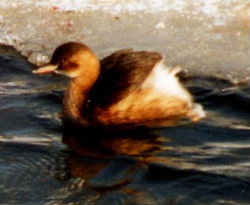Little Grebe
|
|
| Little Grebe | ||||||||||||||
|---|---|---|---|---|---|---|---|---|---|---|---|---|---|---|
 | ||||||||||||||
| Scientific classification | ||||||||||||||
| ||||||||||||||
| Binomial name | ||||||||||||||
| Tachybaptus ruficollis (Pallas, 1764) |
The Little Grebe, Tachybaptus ruficollis , or Dabchick is, at 23-29 cm in length, the smallest European member of the grebe family of water birds.
This bird breeds in small colonies in heavily vegetated areas of freshwater lakes across Europe, much of Asia down to New Guinea, and most of Africa. Most birds move to more open or coastal waters in winter, but it is only migratory in those parts of its range where the waters freeze.
Like all grebes, it nests on the water's edge, since its legs are set very far back and it cannot walk well. Usually four to seven eggs are laid, and the striped young are sometimes carried on the adult's back.
It is an excellent swimmer and diver, and pursues its fish prey underwater.
The adults are unmistakable in summer with a reddish neck and cheeks, with a bright yellow gape. Its breeding call sounds like a horse whinnying. In winter, its size, buff plumage with a darker back and cap, and “powder puff” rear end enable identification. One Cornish bird interbred with a vagrant Pied-billed Grebe.

